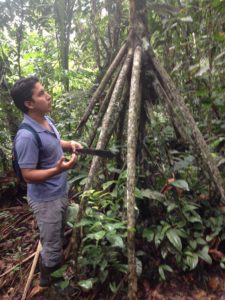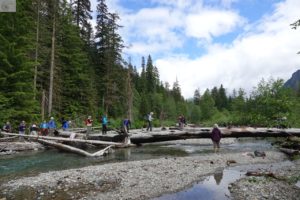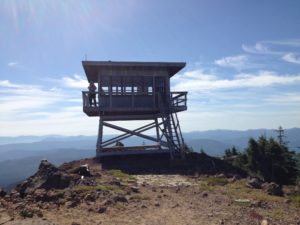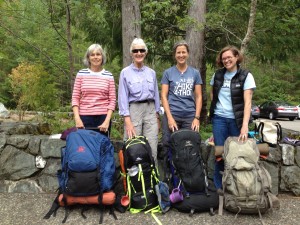When Seattle historian and journalist Bill Kossen told me about his experience on the Iron Horse Trail, I invited him to write a post. As a Northwest native, he has some “cool” history to share:
It was a balmy, early fall day on Snoqualmie Pass and the sprawling parking lot at Iron Horse State Park was nearly empty. Good sign. I was on a mission and didn’t want to be surrounded by a lot of masked and unmasked people. Nearby Alpental was crawling with hikers. I just wanted to see, and possibly hike through, the former railroad tunnel that I read about in Hike 18 of Judy Bentley’s excellent Hiking Washington’s History.
Didn’t know what to expect. The tunnel is hidden from view from the parking lot near the Hyak ski area (now called Summit East) and has a fascinating history that borders on the mystical, thanks to the book. The tunnel and ski area also has a strong, personal pull on me.  One of my earliest memories is of taking the Milwaukee Road Olympian Hiawatha train as part of a family trip to the Midwest back in the summer of 1958 when I was only 3. The train went through the tunnel, but I don’t remember that, just the excitement on being on the rocking, rolling train and getting a souvenir “I Rode On The ‘Hiawatha’ ” bib in the dining car. One of these days, I might frame that bib.
One of my earliest memories is of taking the Milwaukee Road Olympian Hiawatha train as part of a family trip to the Midwest back in the summer of 1958 when I was only 3. The train went through the tunnel, but I don’t remember that, just the excitement on being on the rocking, rolling train and getting a souvenir “I Rode On The ‘Hiawatha’ ” bib in the dining car. One of these days, I might frame that bib.
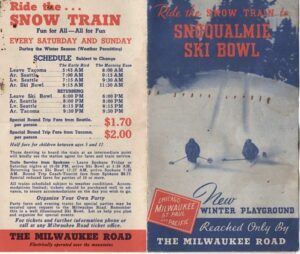 From my parents, I inherited a 1940s brochure about the “Snoqualmie Ski Bowl” and the Milwaukee Road’s “Snow Train” that took them there, dropping them off at a ski lodge after exiting the tunnel. Mom told me about it, but the train and the “Ski Bowl” were long gone by the time I began skiing in the early 1960s. Things had changed dramatically at Snoqualmie Pass by then.
From my parents, I inherited a 1940s brochure about the “Snoqualmie Ski Bowl” and the Milwaukee Road’s “Snow Train” that took them there, dropping them off at a ski lodge after exiting the tunnel. Mom told me about it, but the train and the “Ski Bowl” were long gone by the time I began skiing in the early 1960s. Things had changed dramatically at Snoqualmie Pass by then.  were three ski areas instead of one and plenty of chairlifts and rope tows instead of none. My parents wanted me to learn as they did, so for the first few trips, they wouldn’t pay for a lift ticket. I had to climb the hill with my skis on, clomping along in herringbone style while the other kids whizzed by on the lifts. That was OK; I learned to ski uphill, too.
were three ski areas instead of one and plenty of chairlifts and rope tows instead of none. My parents wanted me to learn as they did, so for the first few trips, they wouldn’t pay for a lift ticket. I had to climb the hill with my skis on, clomping along in herringbone style while the other kids whizzed by on the lifts. That was OK; I learned to ski uphill, too.
Those memories flooded back as I got out of the car. The temperature in the parking lot was 70, so I put on a light jacket and set out for a half-mile hike on a level, well-maintained gravel trail to whatever was waiting around the bend. A few minutes into the hike, I felt a refreshing, cool breeze. Figured there must be an icy creek or pond hidden nearby. But all I could see were trees and brush alongside the trail. Then as I rounded the bend, the breeze picked up and went from cool to chilly. The reason was looming ahead, the colossal opening to the Snoqualmie Tunnel, a huge and quiet air conditioner.
 A lone biker passed me, switching on his headlamp, and disappeared into the tunnel. Two hikers with a small dog entered the tunnel, too. Tentatively. They stopped after going a few feet and snapped a few pictures while the dog stared at me. Even the pet appeared in awe. I kept my distance until they left and then entered the tunnel, past the ancient wooden doors so huge they could protect a castle. I had hopes of hiking and running to the other end, a little more than 2 miles away, until I turned on my headlamp and two handheld flashlights that suddenly felt very tiny. My, was I unprepared. The darkness sucked up the light like nothing I had ever seen.
A lone biker passed me, switching on his headlamp, and disappeared into the tunnel. Two hikers with a small dog entered the tunnel, too. Tentatively. They stopped after going a few feet and snapped a few pictures while the dog stared at me. Even the pet appeared in awe. I kept my distance until they left and then entered the tunnel, past the ancient wooden doors so huge they could protect a castle. I had hopes of hiking and running to the other end, a little more than 2 miles away, until I turned on my headlamp and two handheld flashlights that suddenly felt very tiny. My, was I unprepared. The darkness sucked up the light like nothing I had ever seen.
But I hung around in the dark silence for a few minutes just to take it all in. Would I hear echoes of the hundreds of tunnel workers who chipped and blasted their way through the rock a century ago? Would I see a ghost train roll by illuminating the pitch-black tunnel? The book had triggered my imagination. Hike 18 ended with this suggestion to those hiking from the other end of the trail (or closer starting points), 21 miles away on the west side of Snoqualmie Pass: “To relieve the long miles, imagine the headlight of an orange and black locomotive of the Olympian Hiawatha, carrying revelers high over the creek ravines, through the long dark tunnel, along the river canyons, and into the bright sunlight at the peak of the Cascades.” It worked. I’m hooked and now looking forward to hiking to the tunnel from the other side, where you get to cross trestles high above those creek ravines and have a better chance of seeing that historic headlight. What a cool trek.



